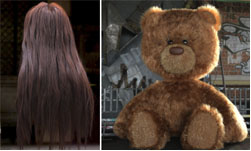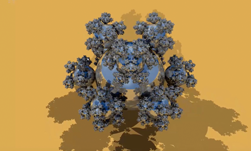Hardware support for ray tracing triangle meshes was introduced as part of NVIDIA RTX in 2018. But ray tracing for hair and fur has remained a compute-intensive problem that has been difficult to further accelerate. That is, until now.
NVIDIA GeForce 50 Series GPUs include a major advancement in the acceleration of ray tracing for hair and fur: hardware ray tracing support for the linear swept sphere (LSS) primitive. This new primitive is a big step toward rendering high-quality digital humans in real time. The range of applications for realistic human rendering is ever-increasing and includes AI avatars, film and game characters, graphics research, high-performance scientific computing applications, synthetic data generation, and more.
LSS is available today in NVIDIA OptiX and in the NVAPI SDK. There are advanced examples of real-time hair using LSS with physically based shading models included in the RTX Character Rendering SDK which is part of NVIDIA RTX Kit. RTX Kit is a suite of neural rendering technologies to ray trace games with AI, render scenes with immense geometry, and create game characters with photorealistic visuals. RTX Kit was introduced during the GeForce RTX 50 Series launch.
What is the LSS primitive?
The LSS primitive is a thick, round 3D line with varying radii. Multiple linear swept spheres can be chained together to build 3D curves, sharing vertices where they overlap, similar to how triangles are used to build 3D surfaces. LSS is shaped like a cylindrical or conical tube with spheres optionally capping either end.

If the two endpoints are overlapped so the line has no length, then the line swept sphere becomes just a regular sphere. This can be used for hardware-accelerated particle rendering. To make spheres convenient and memory efficient, this special case of LSS for spheres is being exposed as a separate first-class sphere primitive.
Linear swept spheres aren’t normally meant to be shown in magnified close-up, as in Figure 1. Rather, they are intended to be small onscreen, maybe one pixel wide, give or take. When multiple linear swept spheres are chained together into strands and the camera is pulled back a bit, the sharp angles melt away and these thick lines become thin smooth curves.

LSS indexing
LSS comes with two indexing modes: an explicit list mode, and a semi-implicit mode called successive implicit. In list mode, each segment is specified explicitly using a pair of indices into your vertex buffer. In successive implicit mode, line segments are specified using one explicit index and one implicit index, where the second point is assumed to be the next vertex in the vertex buffer.
Because successive vertices in memory are common and convenient, successive implicit mode is an easy way to save 50% of the memory in the index buffer. Figure 3 shows an example where an explicit index buffer would contain [0,1,1,2,2,3,4,5,5,6]. With successive implicit indexing, the index buffer would be [0,1,2,4,5].

Rendering strand-based curves using legacy hardware
For someone already using the CUDA-based ray tracing API framework NVIDIA OptiX, LSS is already available as the default linear curve type, and works on all GPUs that OptiX supports. The OptiX version of LSS automatically uses a software fallback on GPUs prior to NVIDIA Blackwell GPUs, and the new hardware-accelerated primitive on GeForce RTX 50 Series GPUs, without needing any code changes. If you’re not using OptiX, chances are you’ll need to use an alternative primitive.
When it comes to high performance, tessellated curves are the next best thing to LSS. One option is camera-facing or ray-facing quads. Ray-facing quads have a relatively low memory footprint, though they may need to be oriented during every frame of animation (either hair motion or camera motion).
Disjoint Orthogonal Triangle Strips (DOTS) provide a clever solution for tessellating curves that enables viewing from any angle without having to reorient the triangles every frame to face the camera. This way, if you render static curves, you won’t need to rebuild your bounding volume hierarchy (BVH) when the camera or hair moves. Because triangles have broad support, DOTS can take advantage of existing RTX hardware.
Anyone who wants to use LSS on GeForce RTX 50 Series GPUs can still support ray traced strands on older GPUs using DOTS. Some hair examples using both DOTS and LSS will be available as part of the RTX Character Rendering SDK that implements path tracing of realistic human hair and skin.
One advantage of LSS is that the geometry is naturally round, making it easy to shade and easy to avoid self-intersection when casting shadow and reflection rays. Tessellated curves like DOTS will typically need to have the geometric normal overridden by a custom shading normal, as shown in Figure 4. When rounded shading normals are used, then the appearance of DOTS can be similar to or even indistinguishable from the appearance of curves made out of linear swept spheres.

Benefits of using LSS
Some of the existing approaches to real-time hair include:
- Textured cards
- Ray-facing quads, tessellated tubes, orthogonal quads (DOTS)
- Software higher-order curve primitives (cubic Bezier, for example)
Textured cards have been a good way to achieve a reasonable enough quality for hair in games on a very light budget. However, this kind of setup is extremely limited and does not allow much room for simulating or animating hair. Since a textured card has multiple strands per card, there is no control over individual strands, by design. Strand-based approaches are far more controllable and flexible, and this is one reason why strands are clearly the future of real-time hair rendering as the world’s hardware improves over time.

Since triangles are well supported in hardware these days, tessellating curves into triangles (tubes, quads, DOTS) can be very fast to render. The downside is that tessellating takes time and can use a lot of memory. A quad requires four vertices, though two vertices can be shared with the next successive neighboring quad in the strand. So on average, camera facing quads will cost at least two vertices per strand segment. If tubes or DOTS are used, then the strand will end up with more than two vertices per segment on average.
LSS only needs one vertex per strand segment on average, so it uses much less memory than tessellated curves, while achieving higher rendering speeds. And LSS is of course much faster than software higher-order curve primitives, like the cubic B-spline. Depending on the needs and tolerance for quality, this extra performance may come with a memory tradeoff compared to cubic curves, for example, if more vertices are needed for smoothness.
What else can LSS be used for?
The RTX version of the linear swept sphere was designed mainly with hair and fur in mind, but it can be used for other applications including particles, molecular models, wireframe rendering, font and path rendering, and whatever else you can imagine.

Get started with LSS
RT Cores in the NVIDIA GeForce RTX 50 Series GPUs introduce hardware support for a new primitive called linear swept spheres (LSS). LSS is a round 3D line primitive with varying thickness, enabling flexible approximation of various strand types. As a special case of LSS, the GeForce RTX 50 Series GPUs hardware primitive also supports spheres directly (without a swept linear segment), which is useful for applications like particle systems.
Rendering animated hair on humans is about 2x faster with LSS compared to DOTS, while also requiring about 5x less VRAM to store the geometry. This is similar for other common use cases. With LSS on GeForce RTX 50 Series GPUs and DOTS for earlier GPUs, there is now a way to get the highest possible hair ray tracing performance on all RTX GPUs.
When ray tracing in CUDA, LSS is currently available in OptiX. For DirectX, API for LSS can be found starting in the R570 version of the NVAPI SDK. Vulkan developers will be interested in the Vulkan LSS extension.
For examples of physically based hair rendering, check out the RTX Character Rendering SDK. To learn more about the latest AI and rendering technologies, check out the NVIDIA RTX Kit. Join the conversation about LSS on the OptiX NVIDIA Developer Forum.











